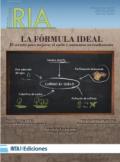Ver ítem
- xmlui.general.dspace_homeCentros e Institutos de InvestigaciónCIRN. Centro de Investigaciones de Recursos NaturalesInstituto de FloriculturaArtículos científicosxmlui.ArtifactBrowser.ItemViewer.trail
- Inicio
- Centros e Institutos de Investigación
- CIRN. Centro de Investigaciones de Recursos Naturales
- Instituto de Floricultura
- Artículos científicos
- Ver ítem
Producción de plantines de petunia (Petunia híbrida) en sistema flotante
Resumen
El sistema flotante es un tipo de producción hidropónica de plantines muy utilizado en el sector tabacalero argentino, pero en el sector florícola es nuevo y no está muy estudiado y difundido. Este sistema permite reducir la mano de obra y el uso de agua con respecto a otros sistemas de cultivo. Por otra parte, las plantas de petunia (Petunia hybrida) son muy cultivadas y requieren plantines de calidad. Por lo tanto, evaluar el sistema flotante con
[ver mas...]
El sistema flotante es un tipo de producción hidropónica de plantines muy utilizado en el sector tabacalero argentino, pero en el sector florícola es nuevo y no está muy estudiado y difundido. Este sistema permite reducir la mano de obra y el uso de agua con respecto a otros sistemas de cultivo. Por otra parte, las plantas de petunia (Petunia hybrida) son muy cultivadas y requieren plantines de calidad. Por lo tanto, evaluar el sistema flotante con esta especie y lograr un plantín adecuado constituye un aporte valioso para el sector. El objetivo del presente trabajo fue producir plantines de petunia en sistema flotante como alternativa al sistema convencional. Se realizaron dos ensayos, en uno se comparó el sistema flotante frente al convencional con tres dosis de fertilizante (19-19-19): 71,5; 31,5; 59,4 mg L-1 de N-P-K, 143; 62,9; 118,7 mg L-1 de N-P-K y 286; 125,8; 237,4 mg L-1 de N-P-K, y en otro se compararon diferentes tipos y volúmenes de bandejas de siembra: 228 celdas de 10 cm3, 216 celdas de 15 cm3, 288 celdas de 10 cm3 y 288 celdas de 17cm3. Al finalizar ambos ensayos se midió por separado la masa seca de la parte aérea, radicular y total. Como resultado, se observó que los plantines obtenidos en el sistema flotante lograron mejor desarrollo que en el sistema convencional. Los plantines lograron un mayor desarrollo fertilizados con 143; 62,9; 118,7 mg L-1 ppm de N-P-K. El tamaño adecuado de bandeja fue de 228 celdas de 10 cm3. En este trabajo se logró obtener el manejo apropiado para producir plantines de petunia en sistema flotante.
[Cerrar]
The floating system is a type of hydroponic seedling production system widely used in Argentina’s tobacco industry, but this system is new and it has not been very studied and disseminated in the flower industry. This system reduces the hand labor and the water used compared to other cropping systems. On the other hand, the plants of petunia (Petunia hybrida) are very cultivated and require of quality seedlings. Therefore, to evaluate the floating
[ver mas...]
The floating system is a type of hydroponic seedling production system widely used in Argentina’s tobacco industry, but this system is new and it has not been very studied and disseminated in the flower industry. This system reduces the hand labor and the water used compared to other cropping systems. On the other hand, the plants of petunia (Petunia hybrida) are very cultivated and require of quality seedlings. Therefore, to evaluate the floating system with this species and to achieve adequate seedlings is a valuable contribution to the sector. The aim of this study was to produce seedlings of petunia in a floating system as an alternative to the conventional system. Two trials were conducted, one compared the floating system vs. the conventional with three doses of fertilizer (19-19-19): 71,5; 31,5; 59,4 mg L-1 of N-P-K, 143; 62,9; 118,7mg L-1 of N-P-K and 286; 125,8; 237,4 mg L-1 of N-P-K; and in the other were compared different types and volumes of seed trays: 228 cells of 10 cm3, 216 cells of 15 cm3, 288 cells of 10 cm3 y 288 cells of 17cm3. When both of these essays were finished, the dry mass of aerial part, root and total dry mass were separately measured. As a result, it was verobserved that the seedlings obtained in the floating system achieved better development than in the conventional system. The seedlings fertilized with 143; 62,9; 118,7 mg L-1 ppm of N-P-K achieved greater development. The appropriate size of the seed tray was 228 cells of 10 cm3. In this work was possible to obtain the proper management to produce petunia seedlings in floating system.
[Cerrar]

Autor
Barbaro, Lorena Alejandra;
Delucchi, Gustavo;
Karlanian, Monica;
Fuente
RIA, 41 (2) : 208-214
Fecha
2015-08
Editorial
Gerencia de Comunicación e Imagen Institucional, DNA SICC, INTA
Formato
pdf
Tipo de documento
article
Palabras Claves
Derechos de acceso
Abierto
 Excepto donde se diga explicitamente, este item se publica bajo la siguiente descripción: Creative Commons Attribution-NonCommercial-ShareAlike 2.5 Unported (CC BY-NC-SA 2.5)
Excepto donde se diga explicitamente, este item se publica bajo la siguiente descripción: Creative Commons Attribution-NonCommercial-ShareAlike 2.5 Unported (CC BY-NC-SA 2.5)


